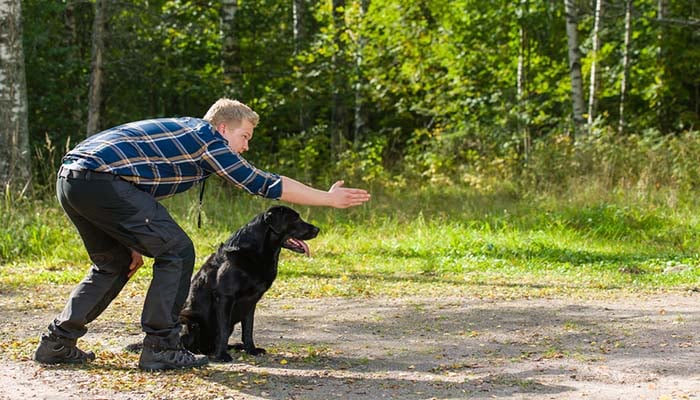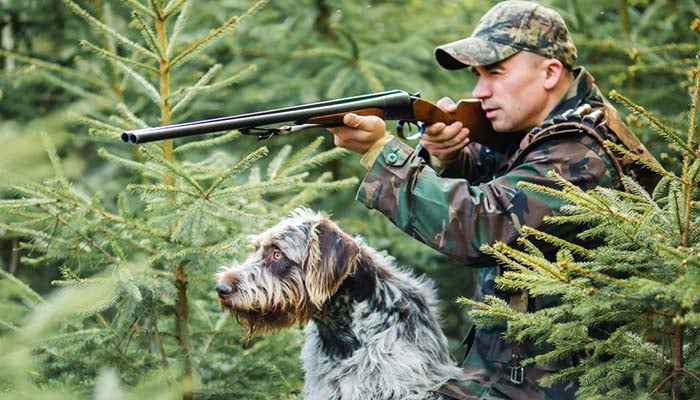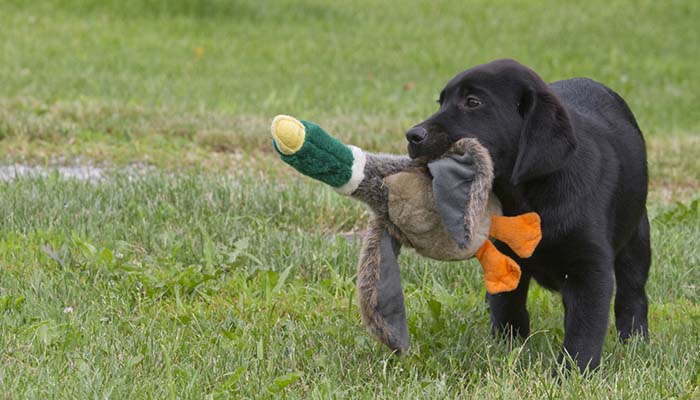The initial aspects of training a hunting dog can seem daunting.
But when you break down the process into its key goals and basic timeline, any dog owner can become a training professional, just as almost any puppy can grow into a hunting professional.
While many within the hunting community recommend a full-blood breed that comes from a reputable breeder that may or may not specialize in breeding and raising hunting pups, the truth is, that any motivated owner and puppy can grow into each other’s ideal hunting companions.
The below hunting dog training tips will work for nearly any canine.
ALSO READ: 30 Best Hunting Dogs for All Types of Game
Key Elements of Hunting Dog Training
1. Gauging their interest
A great way to test your pup’s future abilities or interests in hunting is to gauge their reactions to animals and birds while out on walks.
Do they freeze up and stare with a passionate concentration at squirrels in the park?
Do they stick their tails straight up into the air and go rigid with alert, intelligent ears perked up?
Maybe your pupper even raise one of their front paws, in a classic “pointing” posture.
All of these are good signs that your puppy may have the fundamental building blocks of a future hunting dog.
2. Steadiness
You want your dog to be interested in and to enjoy hunting with you. But what’s more important is their steadiness.
Steadiness is a term you may commonly hear in the hunting community that could easily be replaced with “obedience” or “restraint”.
You want your canine companion to understand the meaning of the words “No” and “Whoa” (meaning to stop immediately and await further instruction).
If your dog is not properly raised to respect your commands and be obedient then it will not be a steady hunting dog.
Instead, their zeal for the job will result in them going after prey before you command them to.
Teach your puppy steadiness by building their ability to perform around distractions: take them to a park and request that they sit and stay while distractions occur around them and treat them heavily for compliance.
Continuously change up your dog's environments while practicing steadiness.
In your hunting career together, it’s likely you will explore many different outdoor environments, and keeping them on their toes and keyed in on you while around new places and smells will strengthen their ability to obey and show some restraint.
3. Positive association
Positive association is one of the most useful and efficient ways of conditioning a dog to behave in ways we want the dog to perform certain tasks.
The most important characteristic for a good hunting canine companion is someone who will listen and follow instructions; you want your puppy to always come when called.
Therefore, the hunting dog training tool known as “positive association” will be one of your most-used devices.
Dogs are motivated in different ways. Some love toys; the squeaker, the better please! While others are extremely food-motivated.
Through trial and error, you’ll find what most motivates your individual pupper and when you do, you’ll use that source to create positive association moments.
There are several key moments that will help you mold a great hunting dog utilizing positive association, including the following points I mention.
4. Off-Leash training
Off-leash training is crucial. Take your dog to a relatively quiet, distraction-less outdoor environment and let them walk alongside you, leash-free.
When they wander off, even just a little, call them back to you using a whistle or calling their name or use the command “Come!”
When they return to you, give them plenty of treats and attention.
Repeat this process.
Eventually, when you get a reliable recall, you can take them to more populated trails or parks.
To ensure a reliable recall, never call your dog to you while they’re in pursuit of something (sniffing the ground) or relieving themselves.
You want to only call the dog to you when you’re 100% sure they will respond as you want.
Otherwise, you’re just teaching them to ignore you.
5. Kennel training
It’s likely you’ll be transporting your dog in a travel crate for your hunting excursions and so positive association can be utilized to help them love their crate.
Keep a soft blanket in the dog crate; not only does this help absorb any moisture or mud they obtain in the field, it also provides comfort.
Additionally, you can hide strong-smelling treats within the folds of the blanket, giving the dog a fun, time-occupying game to look forward to.
Introduce your pup to the kennel not by forcing them inside of it, but by allowing them to explore it themselves.
Every time they sniff or walk toward the kennel, praise and treat them.
Then you may throw a treat or two just on the edge of the kennel’s threshold, even if they put just one paw inside the kennel to timidly retrieve the treat, praise them.
Continue this positive association training until you can get them all the way inside the kennel and with a shut door.
6. Gun training
More on the association of loudness to the gun a little later.
For now, positive association with guns should start not with it being fired, but with it simply being seen by the dog.
Because it’s not safe to have a gun laying around the house, employ a toy gun, something that closely resembles the real thing but is made from plastic.
Now have the toy gun with you or around the puppy whenever something fun occurs. This could be feeding time; you may choose to sit beside your pup as they eat, pretending to clean or shoot the gun.
This could be walks, but be sure to not startle your neighbors.
Either way, you want your dog to positively associate the sight of a gun as well as begin to see it as an extra limb of yours.
7. A strong bond
Rarely overlooked yet always under-hyped, a strong bond with your canine companion will make for an easier time training.
Why?
A dog that loves and respects you will be keener to pay attention to you and make you happy, meaning you receive not only the limitless affection and loyalty from them but also a higher success rate when teaching them new tricks or tasks.
Facilitate a strong bond with your dog at an early age by giving your puppy undivided attention.
Pet, play, and walk them as often as your day allows. Reinforce their desire to seek you out by always paying attention to them when they walk or run up to you.
You may do this in the form of giving them treats, verbal affirmation, and/or a well-deserved scratch behind the ears.
8. Controlled freedoms
Since one of the core qualities of a good hunting dog is obedience, it should come as no surprise that you may have to deny them some of the freedoms other puppies enjoy.
Because you will rely on your companion to either help you track, point, and/or retrieve, you may want to consider banning certain games from your household.
A puppy that learns how good of a time it is to play tug-of-war or keep away may be more inclined to do the same with the fowl or game they retrieve in the future.
For many dogs, it’s difficult to discern where playtime ends and begins, which is why a game of tug-of-war is best not encouraged.
Another means of controlling your hunter-in-training is to not allow them to wander.
It will be easier to train obedience if the dog associates being outside with loyally staying by your side unless otherwise told to.
For this reason, dog parks may be visited at your discretion.
While canine-to-canine interaction is vitally important to not only a dog’s happiness and social skills but also plays a key factor in their temperament, dog parks may give your pet a chance to pick up a few bad habits.
It’s better to find a close friend or family member with a well-behaved dog and facilitate play dates in the comfort and safety of your home or yard.
Another normality for the puppy should be their crate or kennel.
Early crate training is essential in conditioning a reliable and happy hunting dog.
With the correct means of introduction, your pet will come to associate their crate with positive experiences and therefore positive expectations.
To begin crate training, fill the kennel with soft, comfortable blankets and their favorite toys and treat them excessively whenever they’re inside the crate.
In the future, this will make it easier for you to transport canine companions during excursions.
Additionally, not allowing your pet to wander around the house freely while you’re not home will keep them out of trouble, safe, and understanding of the hierarchy of the home.
9. Proper introduction of gun sounds
The use of guns is the last part of proper hunting dog training, once you've gone through everything above.
Because a key part of hunting will be the loud noise of a gun or multiple guns going off at once, it’s important to properly introduce your future hunting partner to gun sounds.
For starters, you should never fire a gun just to see how the puppy reacts.
You’re more likely to create irreparable damage, not only to their hearing but also to their new-gained fear of loud, booming noises.
Instead, start with simple, more routine sounds.
You need to desensitize your pooch to these loud sounds starting with least intrusive ones.
You may choose to clap your hands or stomp.
You could clang some pots around in the kitchen or even just play loud music.
Your intention is not to scare the pup, but rather normalize loud sounds.
It’s important to create these noises while the dog is occupied and not just staring up at you.
Let them become entertained and preoccupied in play with another household pet or with a family-member as they throw a ball around the living room or back yard.
During their playtime, randomly make a loud sound.
Continue this throughout their puppyhood.
Bring The Right Dog Hunting Tools
If it were me, I would plan for days before and have it all together before we shove off. Different hunts require different tools too.
When I go hunting, I make sure I bring an emergency aid kit in case something were to happen.
One of the most important things you need is an orange hunting vest for your pup. You want to make sure any other groups see your dog so they don't get hurt or worse.
My dog loves her little stuffed mallard toy, so I bring that, along with a water bowl and her favorite freeze-dried treats.
This way she's good to go for a few hours.
RELATED: Shed Hunting Dog Training – How to Train Your Pooch to Find Antlers
Frequently Asked Questions
How Do I Get My Hunting Dog in Shape?
Here are some tips on keeping their mental and physical stamina in top condition:
- Go on plenty of runs and walks
- Make sure they stay lean and are on a great diet that fits their nutritional needs
- They need to build up their mental stamina, so frequent hunting training is necessary. Don't overdo it, but they need lots of reps for those longer hunting trips.
How Do You Take Care of a Hunting Dog?
- Make sure they get all of their vaccines
- Make sure they are well hydrated and well fed for hunting adventures
- Pavement is different than out in the bush. Make sure you have some form of routine care for their feet and paws.
- Make sure you have stocked up on fleat and tick treatment.
- Give them plenty of time to rest and recover for the next run. Hunting can be draining for a dog.
A Helpful Hunting Dog Training Timeline
2-4 months old
The first few months of puppyhood are crucial to the outcome of the animal’s temperament.
While there isn’t too much training – of the mental or physical sort – occurring at this early stage of their lives, there is still plenty being learned, albeit subliminally.
Simply put, you’re chaperoning your puppy’s life and ensuring they’re learning how to be a dog.
Socialize your pet and slowly introduce your puppy to people of all sizes, smells, races, and ages.
At the same time, make a point to foster positive experiences with subjects that may be frightening: meeting another, much larger dog (be sure your puppy is only interacting with good-natured dogs that you know well and trust), going to the vet for the first time, hearing loud sirens or fireworks, seeing someone with an odd object, like a bike, umbrella, or crutches.
Slowly but surely, your puppy’s fear with the world will be replaced with confidence, making them a well-rounded, trainable, lovable pet.
For a future hunting companion, your puppy will benefit from playing and walking outdoors.
You may also purchase toys specifically designed with hunting breeds in mind: pheasant pelts, fowl or rabbit dummies and/or durable rubber toys that float in water.
Additionally, you may consider purchasing scents, which contain the essence of anything from quail to rabbits to deer.
These breaking scents can be rubbed onto your pet’s training toys, familiarizing them with what will one day become their greatest objective.
Avoid plush or squeaking toys that promote chewing as it could result in them gnawing on retrievals in the future.
4-6 months old
By this point your pup should be able to adequately walk while on a leash and be comfortable wearing a collar and/or dog harness.
They may or may not have one to two acquaintances for puppy play dates, and they’ve received all their necessary vaccinations from their first couple visits to the vet.
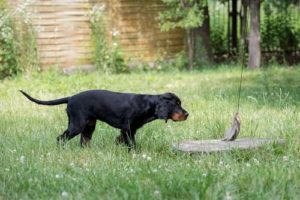 Time to begin the very first steps into hunting dog training and introducing sights, sounds, and smells that they will one day become all too familiar with while out hunting with you.
Time to begin the very first steps into hunting dog training and introducing sights, sounds, and smells that they will one day become all too familiar with while out hunting with you.
One of the most important of these is the sound of gunfire which can be especially frightening to animals.
As I have explained above, this should be a slow and steady introduction; at first, beginning with common household noises that are loud and sudden and working your way to the sound of a fired gun.
6 months to 1 year old
Slowly ease your pup into the cacophony of actual gunfire.
Try to find a park or trail that’s a safe distance from a shooting range.
The dog will hear the sounds but from a distance and as a much more muted sound.
Every time they hear the sound, give them plenty of treats and belly-rubs.
You may also choose, once they get closer to a year old, to start gunfire training with .22 blanks and work your way up to the sound of a shotgun.
It’s also during this time that your puppy is likely to experience its “adolescence” stage, which comes with pronounced bursts of energy.
While it’s always necessary to give a dog plenty of outlets for activity, it’s especially important here as their muscles and personalities are still developing.
Honor this time of growth with long walks, challenging hikes, and/or long, heart-pumping games of fetch.
1 to 2 years old
While many hunting enthusiasts and dog training professionals claim all basic, essential hunting skills are learned by the age of two, it’s important to note that every dog is different and not every trainer they look to for coaching is created equal.
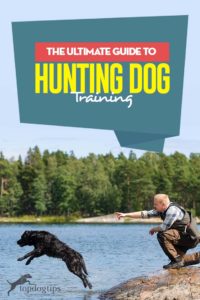 In truth, training your dog for hunting or otherwise should never end.
In truth, training your dog for hunting or otherwise should never end.
However, with consistent and intentional training, your canine companion should have the gist of what you expect from them while on the field.
2+ years old
Through your mutual enjoyment of the pastime, you and your pup should be continuously learning together.
Dogs, especially hunting breeds, love to please, which means their quality of life is always improved when they’re learning and being rewarded for accurately applying what they’ve been taught.






